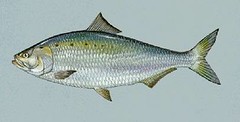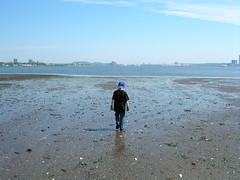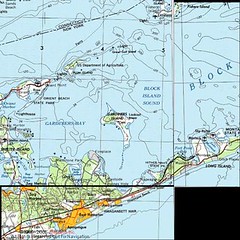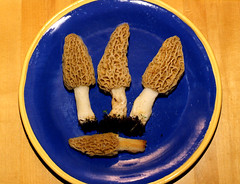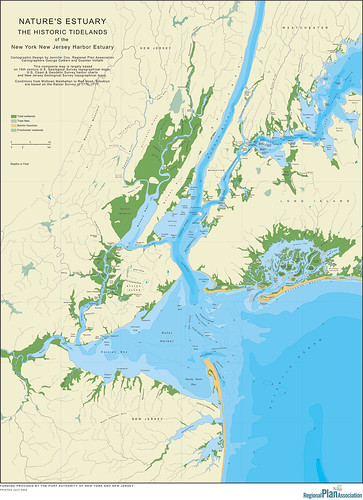My wife and I were invited to the Riverkeeper fundraising dinner at Pier 60 in Manhattan last night by two old friends, Liz Barratt-Brown and her husband, Bos Dewey. We arrived at the same time as Dana Reeve, a neighbor of ours and a slight acquaintance. Dana got out of her car and entered along the carpet, pausing so a densely-packed group of photographers could take her picture. News photographers have a trick, when staking out a celebrity, of calling out the person’s first name in a friendly voice; reflexively the person looks up, at which point the photographer can take a good shot of what might otherwise be an unwilling subject. Even with a willing subject last night they used the technique, calling out “Dana!” and “ Dana!” over and over, presumably so they each could get a picture of her looking into their lens.
But what was Dana Reeve doing at the Riverkeeper dinner, and why were the paparazzi there? I knew the answer of course. Back in October of 1997, after the publication of The Riverkeepers, the book that Bobby Kennedy Jr. wrote with John Cronin, I was working on a profile of Kennedy, and I drove with Cronin to a book party on 57th Street. I was to meet Kennedy there and then drive back up to White Plains with him. Cronin’s cell phone rang when he was on the FDR Drive and someone told him that Bobby wouldn’t be able to make it to the party. John was clearly upset and anxious. If Bobby couldn’t make it, John Cronin would be the show: “And Ivana Trump’s not coming all the way across town to see me,” he said.
Last night the same principle held true – Dana Reeve and a long list of others weren’t coming all the way across town to see anyone but Bobby Kennedy. It made for an interesting evening and a great deal of enthusiasm for environmental protection, but it left me with two unanswerable questions: Who could be Long Island Sound’s Bobby Kennedy? Can
anyone be Long Island Sound’s Bobby Kennedy?
While Dana was occupied by the photographers, Gina and I managed to walk in unnoticed. I shook hands with Alex Matthiessen, who replaced Cronin as Riverkeeper and who was greeting people as they arrived. Cocktails were in a pleasantly crowded lounge with views across the river and to the north. We met Liz and Bos almost immediately, and as we were talking I noticed that Tony Bennett was standing near the wall. He appeared to be with another man, and was not attracting much attention, and I made a mental note to go over and shake his hand, but cocktails were soon over and the crowd moved into the dining room and I lost him.
The podium was against the south wall of the room, which ran out from the West Side Drive into the river. Four large video screens projected the goings-on. First up was John McEnroe, who is on Riverkeeper’s board and was the master of ceremonies. McEnroe’s talk wasn’t particularly funny, and it sounded as if he had had someone write it for him, and judging from the fact that he read it from a handful of sheets of paper and occasionally stumbled over phrasing and emphases, he clearly had not spent much time reviewing it beforehand.
Matthiessen, on the other hand, gave a good, casual talk, and promised that Riverkeeper’s attorneys would soon stop the big development at Bellayre, in the Catskills, and would shut down Indian Point within two years. This latter promise seemed to be optimistic, to say the least. When Alex circulated later, walking from table to table to meet people, I asked him if his father, Peter Matthiessen, was there and if he was, could he introduce me, but he said no, his father rarely came into town for these kind of events.
The dinner’s main course was fish, which, for a few ghastly seconds, we all thought might be Chilean sea bass, the most unacceptable of fish for environmentalists to eat. Liz asked the waiter, who took a menu out of his pocket and told us the fish was cod, which isn't exactly thriving but which I guess isn't in as bad a shape as Chilean sea bass. Someone cracked that maybe the next course would be snow leopard chops, which made me wish I had been quicker so I could have said leatherback turtle eggs were next.
McEnroe introduced Kennedy by saying he hoped one day he’d be our governor or senator or president. Kennedy said the problem with politics is that you have to spend a lot of time with people you don’t like, whereas with Riverkeeper he spends a lot of time with people he likes, people who are really part of his extended family.
Next came the auction, which consisted solely of Ipods, each programmed by a different performer – Sheryl Crow, Bennett, Elvis Costello, Jon Bon Jovi, Lenny Kravitz. They fetched up to $20,000 each. The auctioneers were Uma Thurman, who was very pleasant to watch but not very good at keeping the bidding going, and Cedric the Entertainer, whose real name is Cedric Kyles and who introduced himself as Cedric Kyles Kennedy, an allusion to Bobby’s remark about his extended family. Uma wondered aloud why a joke like that would land with such a thud, although Bobby himself, when he took the stage later, thanked "Cedric Kennedy."
During the auction of Ipods, Gina went to the powder room and ran into Elvis Costello in an upper lobby, pacing and working off nervous energy in preparation for performing. She shook his hand, addressing him as Mr. Costello, and told him she was a big fan, and he spoke cordially and casually and said he had become a big supporter of Riverkeeper. When I went to the men’s room a few minutes later, Lorne Michaels was talking on a cell phone on the stairs and Elvis was pacing in the main corridor, drinking from a bottle of Keeper Springs water and unselfconsciously singing “boo-boo-boo-boo-boo” over and over in different notes to warm up his voice. He was shorter and stockier than I had expected, and wore a suit that looked like the one he wore on the cover of This Year’s Model and a fat pink tie with red and blue stripes. His wife, Diana Krall, was prettier than I had expected.
Kennedy said Elvis and Diana had interrupted a rare string of days off and had flown in from Hawaii to be at the dinner, and I remembered that McEnroe had made the point earlier that Bobby has a way of getting people to readily agree to do things they might not otherwise be inclined to do.
Elvis played his acoustic Gibson and sang four songs – “What’s So Funny About Peace, Love and Understanding,” “Milk of Human Kindness,” and two others I recognized but didn’t know the names of. The truth is, I thought Elvis was great in the late 1970s and through most of the 1980s, but I stopped buying his stuff after Spike and lately I think he’s easier to admire than to like. But he played and sang beautifully last night and I admit to having been excited when I saw his name on the program and thrilled again when he was on stage. While he sang, Dana Reeve, who was sitting at Bobby’s table, got up and left, although I don’t think it was because of any dissatisfaction with Elvis.
When the party was over, I wanted to say hello to Hamilton Fish, who had the bad form to lose to Sue Kelly in a Congressional race that I covered 11 years ago when Kelly was swept in during the “Gingrich revolution,” but I had to wait for him to finish a tete-a-tete with Arianna Huffington (I had tried to say hello to him earlier but he was having a tete-a-tete with Uma). Ham is a true blue-blood whose direct lineage goes back to a Nicholas Fish, I believe, an aide to George Washington who named his son after Alexander Hamilton, thus starting a long line of Ham Fishes (a friend of mine who worked for his campaign proposed this for a slogan – “Ham Fish: Two of the Basic Food Groups”). Nevertheless he’s a good guy. Even 11 years later he bemoaned the fact that his vanquisher is still in office, and he said he is pessimistic that Democrats will ever overcome the right wing.
For one night though, all was well in the world of environmental advocacy. Kennedy knows how to flatter his supporters, how to choose inspiring rhetoric (he’s been giving the same basic speech since the first time I heard him talk, in 1988, at Rye High School), and he knows how to demonize the forces of greed and despoliation. So despite Ham Fish’s pessimism, I left feeling good. The event raised well over $1 million for Riverkeeper. Too bad Long Island Sound has nothing comparable.

